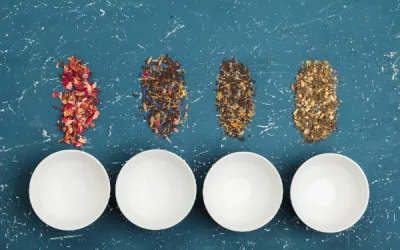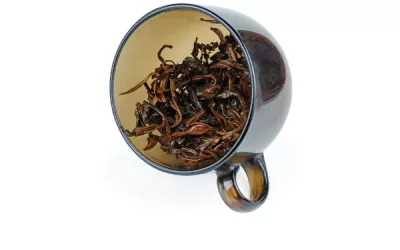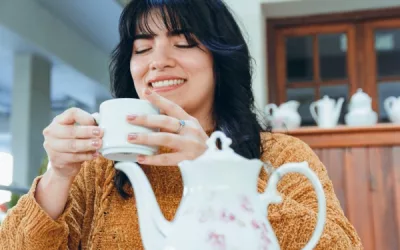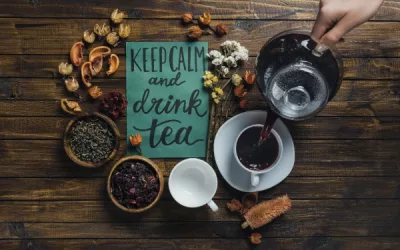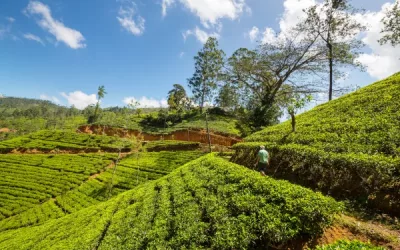Did you know that tea contains not just flavourful notes but also a unique compound called theine, often mistaken for caffeine? As tea enthusiasts and health-conscious consumers seek to understand their brews better, this article delves into the nuances of theine, exploring its differences from caffeine, its physiological effects, and even its impact on sleep. By clarifying these distinctions, we empower you to make informed choices about your tea consumption, highlighting why theine is more than just another buzz word in the tea lexicon.
Table of Content
- What is the difference between theine and caffeine?
- How does the presence of other compounds in tea affect theine absorption?
- Which teas have the highest and lowest theine content?
- Can theine affect sleep quality?
- How can I reduce theine in my tea?
- What are the best teas for those sensitive to caffeine?
- How long should I steep tea to maximise its stimulating effects?
- Conclusion
What is the difference between theine and caffeine?
Theine and caffeine are essentially the same substance; both are forms of caffeine. The term “theine” was historically used to describe the caffeine found specifically in tea. When caffeine was first discovered in tea leaves in the early 19th century, scientists named it “theine.” Later, it was found to be chemically identical to the caffeine in coffee, but the term “theine” stuck around to distinguish tea’s version.
Despite being the same substance, the way theine (or caffeine) interacts with your body varies depending on whether it comes from tea or coffee. These differences arise due to the presence of other compounds in tea and coffee that affect absorption and metabolism.
How do theine and caffeine differ in their effects on the body?
Theine and caffeine might be chemically identical, but tea and coffee influence the body differently due to their other ingredients. Tea contains compounds like L-theanine, which modify caffeine’s effects, making it more gradual and less intense.
- Absorption Rates: Caffeine from coffee enters the bloodstream more quickly, leading to a sudden energy boost. Theine in tea absorbs more slowly.
- Physiological Effects: Coffee’s caffeine often leads to a quick spike in alertness followed by a potential crash. Theine tends to provide a smoother, longer-lasting alertness.
- Interaction with Other Compounds: Tea has L-theanine, an amino acid that promotes relaxation and counteracts the jitteriness caffeine can cause.
- Consumer Perceptions: Coffee is often seen as a stronger, more immediate energy source, while tea is considered a gentler, more sustained pick-me-up.
Understanding these nuances can help you choose between tea and coffee based on how you want to feel.
Why is the term ‘theine’ used specifically for tea?
The word “theine” originated from early scientists who discovered caffeine in tea leaves. They initially thought it was a different compound and wanted to give it a unique name. Even after discovering it was identical to caffeine in coffee, the term “theine” persisted due to:
- Historical Terminology: Early scientific literature and studies used “theine,” which influenced later texts and common usage.
- Cultural Associations: Tea and coffee are culturally distinct beverages with different rituals and consumption habits. Using “theine” helps maintain that distinction.
- Marketing Reasons: Some tea brands use the term to highlight tea’s unique properties compared to coffee.
While “theine” and “caffeine” are chemically the same, the terminology helps underscore the different experiences and effects these beverages provide.
Are there any health implications of consuming theine versus caffeine?
Health implications of consuming caffeine—whether it’s called theine in tea or caffeine in coffee—depend on the quantity and your individual tolerance. Both have similar benefits and risks:
- Benefits:
- Enhanced alertness and concentration
- Improved mood and cognitive function
- Potential protective effects against certain diseases like Parkinson’s and Alzheimer’s
- Risks:
- Insomnia or disrupted sleep patterns
- Increased heart rate and blood pressure
- Potential for dependency or withdrawal symptoms
However, tea might offer additional health benefits due to its other components like polyphenols and antioxidants, which have anti-inflammatory and heart-protective properties.
Understanding these health implications can help you make informed choices about your caffeine consumption, whether it comes from tea or coffee.
When I first started drinking tea, I noticed how different it felt compared to coffee. Unlike the jittery energy boost I got from coffee, tea provided a calming alertness. The ritual of brewing tea, waiting for it to steep, and then enjoying it slowly became a cherished part of my routine.
It wasn’t just about the caffeine; it was about the entire experience, much like how Lipton made tea a daily delight for many.
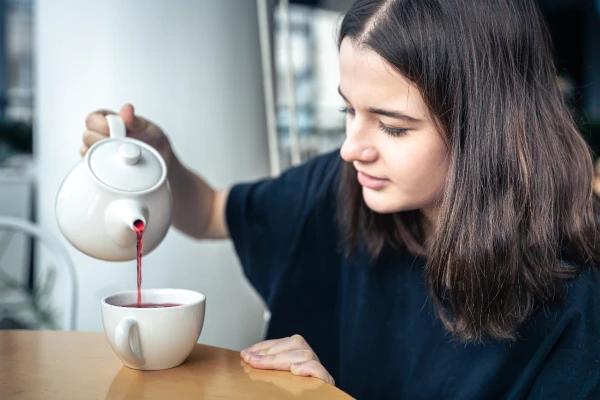
How does the presence of other compounds in tea affect theine absorption?
Theine, which is essentially caffeine found in tea, interacts with various other compounds present in tea. These interactions can change how theine is absorbed by the body and its overall effects.
For example, tannins and theanine, both present in different types of tea, play crucial roles in moderating these effects. Tannins can bind to theine and slow its absorption, while theanine often works to counteract some of the stimulating effects of theine, promoting a sense of calm instead.
Understanding how these compounds work together can help you make informed choices about which tea suits your needs best, whether you’re looking for a morning pick-me-up or a relaxing afternoon brew.
The following table outlines various types of tea, their theine content, and other notable compounds affecting theine absorption.
Types of tea and their theine content
| Tea Type | Theine Content (mg) | Notable Compounds Affecting Absorption |
|---|---|---|
| Black Tea | 40-70 | Tannins, Theanine |
| Green Tea | 20-45 | Tannins, Catechins, Theanine |
| Oolong Tea | 30-50 | Polyphenols, Theanine |
| White Tea | 15-30 | Catechins, Theanine |
| Pu-erh Tea | 30-70 | Tannins, Polyphenols |
| Matcha | 60-70 | Catechins, Theanine |
| Herbal Tea | 0 | Varies (herbal compounds) |
How to use and understand the table
This table can assist in choosing the right type of tea based on your desired theine intake and the effects of other compounds:
- Black Tea: High theine content makes it a strong stimulant. Tannins slow absorption, and theanine offers a balancing effect.
- Green Tea: Moderate theine content with a range of antioxidants (catechins) and theanine for a balanced energy boost.
- Oolong Tea: Mid-range theine content with polyphenols and theanine, providing a mild stimulant effect.
- White Tea: Lower theine, higher in catechins and theanine, making it a gentle option.
- Pu-erh Tea: Variable theine and rich in tannins and polyphenols, offering a unique stimulant profile.
- Matcha: High theine with potent catechins and theanine, making it a powerful yet balanced option.
- Herbal Tea: No theine, with various herbal compounds; great for those avoiding caffeine.
How do tannins affect theine absorption?
Tannins are polyphenolic compounds found abundantly in tea. They affect theine absorption in the following ways:
- Slows Absorption: Tannins bind to theine, which slows its release into the bloodstream.
- Reduces Stimulating Effects: The slower absorption rate lessens the sudden rush of energy, leading to a more gradual increase in alertness.
- Taste Impact: Tannins also contribute to the astringency and bitterness of tea.
- Potential Upset: High tannin content can cause stomach discomfort in some people.
Tannins are more prevalent in stronger teas like black and pu-erh tea. Their ability to bind with theine can make these types of tea less stimulating than their theine content would suggest.
How does theanine influence the effects of theine?
Theanine, an amino acid unique to tea, can modulate the effects of theine in several ways:
- Calms the Mind: Promotes relaxation without drowsiness, counteracting some of the stimulating effects of theine.
- Improves Focus: Enhances cognitive performance and focus when combined with theine.
- Mood Enhancement: Can elevate mood by increasing brain dopamine levels.
- Reduces Jitters: Helps in reducing the jittery feeling that can come from theine intake.
Theanine works synergistically with theine, making teas like green, white, and matcha excellent choices for both alertness and relaxation.
In the early 1600s, tea gained significant popularity in Europe, largely due to Dutch traders bringing it from China. However, it was Catherine of Braganza, a Portuguese princess, who truly made tea a household name in England.
When she married King Charles II, she brought her love for tea to the English court. This began a long-standing tradition and eventually led to the British custom of “afternoon tea”. Catherine’s preference for the beverage influenced British social culture, making tea a staple that remains popular to this day.
I remember the first time I tried matcha. I was curious because I had read so much about its benefits. Preparing it felt like a ritual – whisking the bright green powder into frothy perfection. The experience was both energising and calming.
The theanine really does balance out the theine. Now, it’s my go-to when I need a boost without the jitters of coffee. It’s fascinating how this simple drink can have such complex effects!
Which teas have the highest and lowest theine content?
Alright, let’s dive into the world of teas and theine content, shall we? Theine is just a fancy name for caffeine when we’re talking about tea. And yes, the various types of teas pack quite different amounts of this little pick-me-up substance, swinging from “mild as a kitten” to “rocket fuel”.
When it comes to theine content, it’s basically a boxing match between different kinds of teas. In the heavyweight category, we have black tea. Black tea throws a caffeinated punch that can easily compete with a cup of coffee. This is followed by oolong tea, which packs a mean but marginally lesser punch.
Next, in the middleweights, we have green tea. It’s gentler and easier on your nerves, but still gives you a bit of a jolt. Then there’s white tea, which is the lightweight champion. It’s like whispering in theine’s ear – subtle but there. Last but decidedly least in the theine content match are herbal teas, or tisanes. They don’t even step into the ring because they’re caffeine-free – the herbal wallflowers at the tea party.
What factors contribute to the differences in theine content among teas?
The differences in theine content can be attributed to multiple factors. Don’t worry, I’m not about to drop a chemistry lesson on you. It’s simpler than you’d think.
- Type of tea plant: Different tea plants have different caffeine (I mean, theine) levels.
- Processing method: Black teas are fully oxidized, whereas green and white teas are either unoxidized or slightly oxidized, impacting the caffeine content.
- Growing conditions: Elevation, soil, climate – all contribute to the final theine content.
- Age of leaves: Younger leaves usually have more theine.
- Preparation methods: How you brew it, the temperature and time steeped will alter the theine you end up sipping.
A black tea leaf grown on a mountain in Darjeeling, fully oxidized and brewed strong, will pump significantly more theine into your system compared to a casually sun-dried white leaf, brewed quickly.
How can consumers choose teas based on their theine content?
Picking tea based on theine content is a bit like choosing a dance partner based on rhythm – you want to match your tempo.
- Energy seekers: You want to wake up or stay alert, then black or oolong tea will be your go-to.
- Calm focus: Green tea’s your mate if you want a balanced lift without jitteriness.
- Zen mode: Head for white tea if subtle peace is your thing.
- No theine, no problems: Herbal teas are your best bet – all chill, zero thrills.
Choosing tea becomes about understanding what you want from that cup. Wake-up call? Calming elixir? Herbal lullaby? Your needs guide you straight to the right leafy brew.
Are there specific brands known for low theine teas?
Yes, indeed! Certain brands cater specifically to those who want to keep their theine-intake low. These brands are usually very transparent about their theine levels.
- Teapigs: Known for their environmental credentials and a range that includes caffeine-free options.
- Pukka: They offer a variety of herbal teas that are naturally caffeine-free.
- Celestial Seasonings: Making caffeine-free blends and herbal infusions since ages.
- Rishi Tea: Organic and known for its low-caffeine tisanes.
- Twinnings: A classic that offers decaf versions of their beloved teas.
These brands not only cater to your taste buds but also give you the lowdown on what’s in your cup. Whether you’re avoiding caffeine like the plague or just wanting to cut down, these brands have got you covered.
And hey, did you know that Catherine of Braganza, a Portuguese princess who married Charles II of England in the 17th century, helped popularise tea drinking in Britain? Before her arrival, tea was relatively unknown in England!
She practically made tea cool, and little did those Brits know they’d be forming a national obsession. So next time you sip your carefully chosen tea, raise your cup to Catherine for making teatime a thing!
Can theine affect sleep quality?
Ah, the age-old dilemma: to sip or not to sip that enticing evening cuppa. Theine, commonly known as caffeine in tea, can indeed mess with your precious sleep quality. The relationship between theine consumption and sleep can be a complicated affair, much like a soap opera, but let’s break it down without the melodrama.
First off, timing is everything. Drinking tea loaded with theine too close to bedtime can leave you counting sheep instead of catching Z’s. Second, individual sensitivity to theine varies—what zips you awake might leave your mate snoring peacefully.
And let’s not forget theanine, a compound in tea known for its calming effects, possibly counterbalancing the theine. Now, let’s dive into the nitty-gritty.
How does theine impact sleep compared to caffeine?
Picture this: Both theine and caffeine walk into a bar. They’re twins separated at birth, more similar than not, but with a slight twist.
- Release Mechanism: Theine’s release in your system is slower, taking its sweet time, unlike caffeine’s instant hit.
- Duration: While caffeine from your beloved espresso can keep you zooming for hours, theine’s impact mellows out faster.
- Effect on Body: Theine tends to offer a smoother, subtler energy boost compared to the anxiety-inducing jolt from coffee. Think of it as a gentle nudge versus a slap in the face.
That said, too much theine (or caffeine) and your brain goes into overdrive, ruining REM cycles and making sleep a distant memory.
What types of tea are best for evening consumption?
So, you’ve decided that your evening tea ritual isn’t optional. No worries, there are teas for that. You see, not all teas are equal in theine content, and some are even designed to usher you into a peaceful slumber.
- Herbal Teas: Chamomile, peppermint, and rooibos. These teas are caffeine-free and calming—think of them as a lullaby in a cup.
- Decaffeinated Teas: All the flavour, none of the theine. Useful for those who want the taste without the restless night.
- Green Tea: If you’re adventurous, go for low-theine green teas. They offer the beneficial theanine, which can help relax you.
- White Tea: Generally lower in theine content and packed with antioxidants to boot.
Opt for these before bed and keep your sleep cycle more Norman Rockwell, less Salvador Dalí.
Are there any studies linking theine to sleep disturbances?
Scientific minds have thrown their weight behind this question, and guess what? Theine can indeed disrupt your sleep, but the level of disruption varies.
- Research Findings: Some studies point out that theine, being a form of caffeine, is linked to sleep disturbances, particularly its effect on sleep onset and maintenance.
- Individual Variability: Responses vary based on genetic predisposition, age, and even habitual consumption. It’s like a lottery, but with sleep quality as the prize.
- Comparative Studies: Studies comparing coffee to tea show that the theine in tea generally has a milder disruptive effect on sleep compared to coffee.
If you’re still awake, here’s a nugget from history to chew on: In 1666, London was buzzing, literally, with coffee houses becoming the rage. Thomas Garway started selling tea at his coffee house, Garraway’s, claiming it as a remedy for everything from the common cold to “melancholy fog.” Little did folks know then, throwing theine into the mix could potentially give them more awake time than they bargained for, especially during those sleepless London nights.
So, next time you reach for that evening brew, remember: Drink smart, and sleep tight!
How can I reduce theine in my tea?
Tea enthusiasts and health-conscious folks, I get it. You love your tea but don’t want to stay up all night wired like a teenager downing energy drinks. So, reducing theine (the posh term for caffeine in tea) is your goal. Let’s dive straight in!
First off, let’s talk technique. If you want to lower theine in your cuppa, you’ve got options.
What is the most effective method for reducing theine?
Here’s the no-nonsense truth: rinsing your tea leaves before brewing is the winner.
- Give your tea leaves a quick dunk in hot water.
- Steep them for about 30 seconds, discard that water, and then brew as usual.
- This method discards much of theine released initially.
- Works with most tea types, whether you’re into green, black, or oolong.
- Although not foolproof, it’s the most uncomplicated and effective starting point.
So, next time you’re prepping your favourite Earl Grey or matcha, remember to give those leaves a mini-swim before diving in for the real thing.
How does steeping time affect theine levels?
Now, adjusting steeping time – the perfect way to play mad scientist with your brew.
- Steeping time is directly proportional to the theine content.
- The longer you steep, the more theine gets released.
- For a low-theine brew, aim for a steep time of around 1-2 minutes.
- Experiment with white and green teas that naturally require shorter steeping.
- Try multiple short steeps; this can gradually extract the flavour without a theine overload.
With this approach, what you’ll get is a pleasant, gentle pick-me-up rather than the caffeine-jacked rocket shot you might otherwise experience.
Are there any specific brewing techniques recommended for low theine tea?
Absolutely, there are specific strategies to keep your theine intake in check.
- Opt for low-theine tea types like herbal teas, rooibos, or decaf variants.
- Cold brewing – steep your tea in cold water for 6-12 hours.
- Use larger tea leaves instead of tea bags as they generally contain less theine.
- Adjust the tea-to-water ratio. More water and fewer leaves = lower theine.
- Choose younger, delicate leaves that naturally have less theine.
A little bit of experimentation here can go a long way. Cold brewing, for instance, might surprise you with its mild and refreshing taste – all while keeping the theine at bay.
Now that you’re armed with these tips, go forth and steep like a pro. Just remember, a small tweak in your method can lead to a significant change in how your body handles the buzz.
And for a quick historical nugget: did you know that Tsar Nicholas II of Russia was an avid tea drinker? He would famously host elaborate tea parties with samovar-brewed tea that’s surprisingly low in theine given the techniques they used back then.
He probably appreciated the gentle kick to keep up with state affairs without losing his sanity – very relatable, don’t you think?
There you have it, folks. Go make the perfect cup and savour every sip!
What are the best teas for those sensitive to caffeine?
Ah, caffeine sensitivity – that delightful condition where one cup of something caffeinated makes you jittery and bouncing off the walls. Fortunately, the tea world offers some saviours. For those of you who can’t handle theine (that’s just a fancy word for caffeine in tea), let’s explore your options.
We’ll dive into herbal teas, decaffeinated teas, and low-theine varieties. Ready to find your perfect cuppa?
Herbal teas are an excellent choice. They’re naturally caffeine-free, and in no short supply of flavours. Whether you fancy a soothing chamomile or a zesty peppermint, the herbal world has your back.
Then there are decaffeinated teas, which still have that traditional tea taste minus the jittery aftermath. Lastly, low theine teas – they have small amounts of caffeine, perfect if you want a mild kick. Let’s break this down further.
Which herbal teas are completely caffeine-free?
Herbal teas, my friend, are your caffeine-free wonderland. Unlike your typical black or green teas, herbal teas are crafted from an array of plants, flowers, and fruits.
Here’s a list of some fabulous herbal brews:
- Chamomile: Calm in a cup, perfect before bed.
- Peppermint: Fresh, minty and great for an upset stomach.
- Rooibos: Earthy and rich, it’s sometimes called “Red Tea.”
- Hibiscus: Tart and fruity, and that stunning red colour is just a bonus.
- Lemon Balm: Citrus-flavoured, uplifting for those dreary days.
These beauties are entirely caffeine-free. They’ll ensure you sleep like a baby and don’t scare your office colleagues with random jittery outbursts. Plus, they come packed with their own health benefits, helping with digestion, relaxation, or just adding a bit of flavourful joy to your day.
Are there any decaffeinated teas that retain flavour?
Decaffeinated teas, worth it? Absolutely! But let’s be real – some can taste like someone tried to make flavoured water but forgot the flavour. However, there are gems that retain rich, robust flavours.
Places to start:
- Decaf Earl Grey: That lovely hint of bergamot stays intact.
- Decaf English Breakfast: Strong, malty and great with a splash of milk.
- Decaf Green Tea: Light and grassy, perfect if you’re stressing the antioxidants.
- Decaf Chai: Spices galore – delightful with a bit of honey and milk.
- Decaf Oolong: Slightly floral and totally relaxing.
Choosing decaffeinated teas that keep their flavour is like finding a needle in a haystack, a very worthwhile haystack. Some processes used to remove theine can strip the goodness, so stick to the superstars above for maximum flavour.
How can individuals identify low theine teas?
Low-theine teas give you the best of both worlds: flavourful tea and less caffeine-induced pandemonium. But how do you spot them?
Here’s the insider scoop:
- White Tea: Generally has less caffeine compared to green or black teas.
- Hojicha: A roasted green tea variant, it’s low in theine and high in comfort.
- Genmaicha: Green tea mixed with roasted brown rice, very low theine content.
- Oolong: Although it can vary, many have lower theine levels.
- Pu-erh: Fermented tea that typically contains less theine after processing.
To identify low theine teas, look for information on the packaging, consult with your local tea merchant, or consider teas that are lightly processed. White teas are a stellar choice since they undergo minimal processing, retaining less caffeine.
Back in 2737 BC, the Chinese legend Yan Emperor Shennong discovered tea when leaves from a wild tree blew into his boiling pot of water. Unknowingly, he brewed the first-ever cup of tea.
Shennong, hailed for his knowledge of agriculture and medicinal plants, might not have imagined the caffeine conundrum his ‘tea’ would later brew up. But wisely, he gave us a variety to choose from, ensuring there’s something for everyone – even those with sensitive caffeine palates.
How long should I steep tea to maximise its stimulating effects?
Well, my friend, if you’re looking for the ultimate buzz from your tea, you’ve come to the right place. The trick is all in the steeping time, water temperature, and type of tea. So let’s break it down and get the most zing for your sip.
Steeping duration is like a dance — too short and you miss the rhythm, too long and you’re just left with soggy, overstimulated leaves. Water temperature, on the other hand, is a temperamental beast — too hot, and you’ll scald your leaves; too cold, and they won’t come to life. And tea type? That’s the star of the show. Each one has its quirks and perks.
Now, let’s dive into the details, so you can brew with confidence and finally punch your tea up to eleven.
What is the recommended steeping time for black tea?
For black tea, the daring diva of the tea world, the sweet spot for steeping is around 3 to 5 minutes. Why the range? Well, it depends on how robust and bracing you want your cup to be.
- 3 minutes: A moderate kick, smooth with just the right touch of a caffeine jolt — perfect for those who don’t want to feel like they’ve had an electrical surge.
- 4 minutes: Stronger, bolder and gets those taste buds dancing with a more vivid experience.
- 5 minutes: Hello, heavyweight! A full-on, no-nonsense mug that’s practically shaking with theine.
And remember, using boiling water (100°C) is essential. Any cooler, and your black tea will feel unappreciated and may not release its full potential.
How does steeping time affect theine release?
Want to get technical? Theine (tea’s version of caffeine) comes out to play when you steep your leaves long enough. Here’s where things get science-y, but don’t worry, I’ll keep it simple.
- Theine starts being released in the first 30 seconds but is really ramping up after the first minute.
- The longer you steep, the more theine is extracted, peaking around five minutes. Hooray for the buzz!
- Too much time, however, and you’ll start extracting tannins, which can make your tea bitter and dry your mouth out like a desert.
So, finding your sweet spot is all about maxing out that theine (or caffeine, for us plebs) without overbrewing and ending up with a tea that could rival cough syrup in bitterness.
Are there any specific temperature guidelines for steeping?
Ah, yes, the temperature dance. Each tea type has its own ideal steeping temp, and getting it right can make all the difference between a perfect cup and an underwhelming one.
- Black Tea: Boiling point, 100°C. It’s the Hulk of teas, needing plenty of heat to unleash its flavour and theine.
- Green Tea: A bit more delicate, 70-80°C. Too hot and it’s basically spinach soup.
- White Tea: Even more fragile, think 65-75°C. Imagine whispering to your leaves, not shouting.
- Oolong: Somewhere in the middle, 80-90°C. It’s the Goldilocks of teas — just right.
- Overheated water can scald delicate teas, making you feel like you’re drinking liquid regret.
- Too cool? You might as well be drinking flavoured water because theine won’t truly hobnob with your cup.
Getting that perfect temp can be as important as the steeping duration to get that ideal buzz and flavour combo.
Now, let’s tie this all together with a bit of history. Way back in the day, in the 19th century, tea was such a colossal deal in Britain that it kickstarted the famous Boston Tea Party. The name’s a bit of a misnomer, as it wasn’t much of a party but more of a “dump”.
Colonists dumped tea into Boston harbour as a big middle finger to the British taxes. Why? Because tea, good old theine-packed leaves, had become the beverage of choice. Imagine being so into your morning brew that you’d launch a rebellion over it. Ah, the stimulating power of tea!
So, grab your teapot, mind your times and temperatures, and steep yourself into a delightful, theine-infused paradise.
Conclusion
Reflecting on the world of theine and its vital role in tea brings to light the intricate dance between chemistry and culture. In exploring the differences between theine and caffeine, we’ve uncovered not only their unique chemical structures but also how our perceptions shape our consumption choices.
The nuances of how theine interacts with other compounds in tea—like tannins and theanine—demonstrate that the experience of drinking tea is as much about the flavour as it is about the health implications.
Understanding which teas pack a higher or lower theine punch allows consumers to make informed choices aligned with their health goals—be it enhancing mental alertness or promoting relaxation before bedtime.
As we’ve seen, factors such as steeping time and tea type can significantly influence the levels of theine, emphasising the importance of brewing practices tailored to individual needs.
In delving into the health benefits of theine, it’s apparent that enjoying a cup of tea transcends mere ritual; it becomes a potential pathway to improved cardiovascular health and stress reduction. For those sensitive to caffeine, the range of herbal and low theine teas ensures that everyone can partake in this soothing beverage without worry.
For anyone seeking to maximise the benefits of their tea experience, I encourage experimentation. Steep your favourite tea with intention, pay attention to how it makes you feel, and don’t shy away from tasting the vast array of options available. Each cup not only warms the body but also nourishes the soul. As I sit here, cup in hand, I find myself pondering: how does my choice of tea today shape my experience tomorrow? Perhaps in this delicate dance of theine, we can each discover a little more about ourselves—one sip at a time.
Resources
- The Effects of Green Tea Amino Acid L-Theanine Consumption on the Ability to Manage Stress and Anxiety Levels: a Systematic Review
- Effects of l-Theanine on Cognitive Function in Middle-Aged and Older Subjects: A Randomized Placebo-Controlled Study
- Effects of L-Theanine Administration on Stress-Related Symptoms and Cognitive Functions
- The Effects of L-Theanine Supplementation on Quality of Sleep: A Systematic Review
- L-Theanine: A Unique Functional Amino Acid in Tea
- Theanine and Caffeine Content of Infusions Prepared from Commercial Tea Samples
- A double-blind, placebo-controlled study evaluating the effects of caffeine and L-theanine both alone and in combination on cerebral blood flow, cognition and mood
- Optimization of extraction conditions for the maximum recovery of L-Theanine from tea leaves


